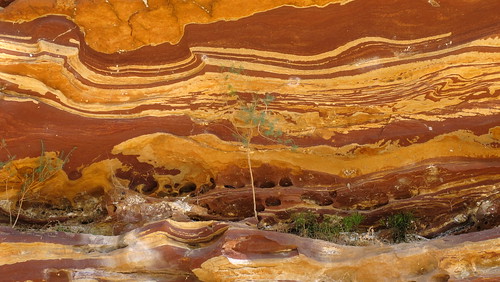Kalbarri National Park covers 1830 square kilometres some 485 km north of Perth in Western Australia. The Murchison River flows east through canyons cut deeply into horizontal bands of multi-coloured sandstone before reaching the Indian Ocean.
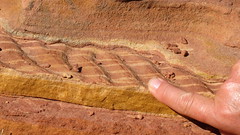 The water-carved canyon walls are dramatic and unexpected, looking more like confectionary than stone. Rippled surfaces embedded within the sedimentary rock formation—called Tumblagooda sandstone—were apparently formed by waves moving over tidal flats some 400 million years ago.
The water-carved canyon walls are dramatic and unexpected, looking more like confectionary than stone. Rippled surfaces embedded within the sedimentary rock formation—called Tumblagooda sandstone—were apparently formed by waves moving over tidal flats some 400 million years ago.
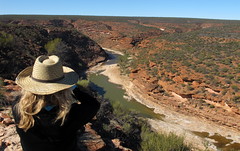 The 8km Loop Walk trail took us along the edge of a cliff overlooking the Murchison River before descending to the riverbed. Although the river was barely flowing in June, remnants of branches and even stones several metres above our heads was a sobering reminder of how much water could flow through.
The 8km Loop Walk trail took us along the edge of a cliff overlooking the Murchison River before descending to the riverbed. Although the river was barely flowing in June, remnants of branches and even stones several metres above our heads was a sobering reminder of how much water could flow through.
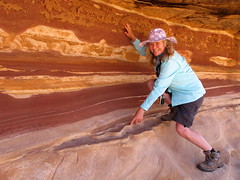 Despite occasional flooding, the gorge provides shelter and food to wildlife. We saw several wallabies along the trail, as well as a small flock of goats—and near the end of the loop, found the skull of a wild boar. A number of different water birds—including several black swans—were feeding on freshwater shrimp and minnows in several of the ponds.
Despite occasional flooding, the gorge provides shelter and food to wildlife. We saw several wallabies along the trail, as well as a small flock of goats—and near the end of the loop, found the skull of a wild boar. A number of different water birds—including several black swans—were feeding on freshwater shrimp and minnows in several of the ponds.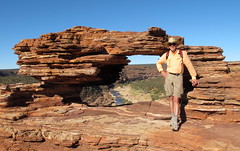
At the end of the hike, we stopped for obligatory photos at a popular destination close to the parking area. "Nature's Window" frames the Murchison River, and there is even a convenient yellow-painted rock for people to stand on for the “best" shot. With no bus tour there as there had been at our start, how could we resist?
Kalbarri is a gem. We would love to return in the spring to see the wildflowers that were evident all along the roads.
